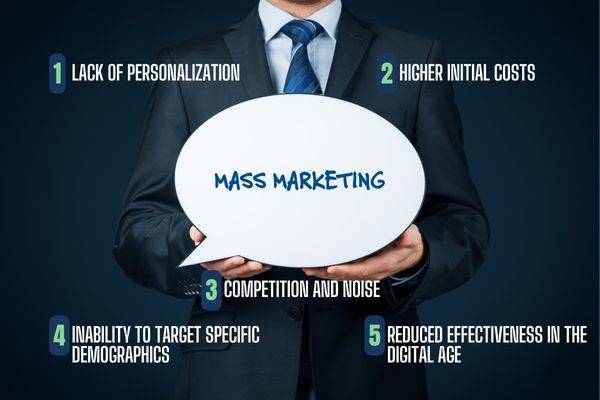Whether you’re familiar with it or just getting started in the marketing field, understanding mass marketing is essential to grasp how businesses communicate with large audiences, often on a global scale. This blog will dive into the details of mass marketing, its benefits, challenges, and best practices. We’ll also explore how mass marketing compares with other strategies like niche and segmented marketing.
Table of Contents
The Basics of Mass Marketing
Mass marketing is a marketing strategy that aims to reach a large, diverse group of people, often with a single message or campaign. This approach is designed to target the broadest possible audience, regardless of specific characteristics like age, gender, or location. Mass marketing focuses on maximizing exposure to a wide consumer base, usually through traditional media channels such as TV, radio, newspapers, and billboards.
One of the primary goals of mass marketing is to build brand recognition and awareness by appealing to a broad audience and offering products or services that are universally needed or desired. Mass marketing often works best for companies offering products or services that have widespread appeal, such as food items, household products, or financial services. Think of major brands like Coca-Cola, Nike, or Apple—they use mass marketing to promote their products to virtually everyone.
Key Features of Mass Marketing
- Large Audience Reach: The main characteristic of mass marketing is its focus on reaching as many people as possible, rather than narrowing down the audience. This wide net approach allows businesses to ensure maximum exposure and create a significant impact.
- One-Size-Fits-All Message: Mass marketing typically involves a single marketing message, delivered in a way that resonates with the broadest audience possible. The messaging is often simple, direct, and not personalized. While this reduces the complexity of the campaign, it can sometimes lack the emotional appeal that more targeted approaches can provide.
- Traditional Marketing Channels: Mass marketing relies heavily on traditional advertising methods such as television, radio, newspapers, and magazines. With the rise of digital marketing, some companies still use these classic channels alongside newer platforms, but the focus remains on reaching the most significant number of people.
- Cost-Effectiveness in High-Volume: Although mass marketing requires significant upfront costs (like large media buys), the potential to reach millions of consumers means the cost per contact is relatively low. This makes mass marketing a favorable option for companies with large budgets and the ability to produce campaigns at scale.
- Focus on Product Category: Mass marketing typically promotes products or services with universal appeal. For example, a toothpaste brand does not need to target a specific demographic since almost everyone uses toothpaste. The goal is to convince people to choose your brand over competitors.
Benefits of Mass Marketing
Mass marketing has been a staple of the advertising industry for decades, and it still holds a key place in modern campaigns. Below are some of the top benefits of adopting a mass marketing strategy:
- Wider Reach and Exposure: By utilizing large-scale platforms like TV or national radio stations, mass marketing ensures that a product or service reaches a broad audience. If you’re a company seeking to establish a nationwide or global brand presence, mass marketing is an effective way to get your message in front of millions of potential customers.
- Brand Recognition and Awareness: Repetition is a core principle in mass marketing. By continuously broadcasting a brand’s message across high-traffic channels, companies can build brand recognition and recall, making it easier for customers to remember their brand when making a purchase decision.
- Cost Efficiency: When executed correctly, mass marketing can reduce the overall cost per person reached, making it a cost-effective solution for brands that want to spread their message across a broad demographic. The larger the campaign scale, the cheaper it becomes per unit of exposure.
- High Impact Campaigns: Mass marketing campaigns often have a profound impact on public consciousness, especially when they use iconic imagery, slogans, or themes that are easily identifiable. Think about Coca-Cola’s “Share a Coke” campaign or Nike’s “Just Do It”—these campaigns were designed to resonate with a wide audience, yet they remain memorable and impactful even today.
- Simplicity in Execution: Mass marketing simplifies the marketing process because the same message is delivered to everyone. There’s no need for intricate audience segmentation, and the creative team can focus on crafting one compelling narrative that appeals to a broad range of people.
Challenges of Mass Marketing
While mass marketing has its benefits, it also comes with its fair share of challenges:
- Lack of Personalization: A single message targeting everyone runs the risk of not resonating deeply with any particular group. Consumers today expect more personalized experiences and may be less likely to connect with mass-marketed products that feel generic or out of touch.
- Higher Initial Costs: The cost of producing a mass marketing campaign—especially when it involves TV ads, print media, or billboards—can be astronomical. For small businesses or startups with limited budgets, this type of marketing may not be feasible.
- Inability to Target Specific Demographics: Mass marketing doesn’t allow for precise targeting of specific consumer needs, preferences, or behaviors. As a result, businesses may waste resources by advertising to people who are not interested in their product.
- Reduced Effectiveness in the Digital Age: With the increasing rise of digital and social media, consumers are becoming more accustomed to targeted ads based on their behavior and interests. This has made mass marketing less effective, as people are inundated with personalized content, making it harder for broad messages to stand out.
- Competition and Noise: Since mass marketing reaches such a wide audience, there’s a lot of competition for consumer attention. Brands are fighting to stand out among thousands of ads in the same space, leading to “ad fatigue” and reduced effectiveness over time.
Also read: The Ultimate Guide to Using a CRM in 2025
Mass Marketing vs. Niche Marketing
One key distinction that businesses should consider when choosing a marketing strategy is the difference between mass marketing and niche marketing.
- Mass marketing targets a broad audience, offering a product or service that appeals to as many people as possible.
- Niche marketing, on the other hand, focuses on a specific segment of the market, targeting a particular group with highly tailored products and messages.
Mass marketing is ideal for large companies with broad consumer appeal, while niche marketing is best suited for smaller businesses or brands looking to serve a specific audience. For example, while Coca-Cola may use mass marketing to target all soda drinkers, a boutique coffee shop may use niche marketing to focus on coffee enthusiasts in a particular geographic area.
Best Practices for Effective Mass Marketing
For businesses to succeed with mass marketing, they must carefully plan and execute their campaigns. Here are some best practices to follow:
- Know Your Audience: Although mass marketing aims to target a broad audience, understanding the overall characteristics and preferences of your target demographic is still essential. It can help you shape your message to appeal to a wide range of people without being too generic.
- Invest in Quality Creative: Since mass marketing relies on large media channels, it’s important to create ads that are visually appealing, memorable, and emotionally resonant. High-quality creative can set your brand apart and leave a lasting impression on your audience.
- Leverage Multiple Platforms: While traditional media is still essential for mass marketing, integrating digital platforms into your strategy can enhance its effectiveness. Consider using social media, online video, and display ads to complement your TV or radio spots.
- Measure Effectiveness: Just because mass marketing campaigns have wide reach doesn’t mean they are always successful. Regularly monitor and assess your campaign’s performance using metrics like reach, engagement, and sales to determine if your message is reaching the right people.
FAQs about Mass Marketing
How is mass marketing different from digital marketing?
Mass marketing focuses on reaching a broad audience through traditional media (TV, radio, etc.), while digital marketing targets consumers through online platforms like social media, search engines, and websites. Digital marketing often allows for more precise targeting based on user behavior and interests.
Is mass marketing suitable for all types of businesses?
Mass marketing is typically best suited for large businesses that offer products or services with broad consumer appeal, such as household items or fast food. Smaller or niche businesses may find more success with segmented or targeted marketing strategies.
Can mass marketing still be effective today?
Yes, mass marketing can still be effective, especially for brands with a large reach and universal appeal. However, with the rise of digital platforms, many businesses are turning to more targeted strategies to ensure higher engagement.
What are some examples of successful mass marketing campaigns?
Some iconic examples of successful mass marketing campaigns include Coca-Cola’s “Share a Coke,” Nike’s “Just Do It,” and Apple’s product launches. These campaigns used broad messaging that resonated with a global audience.
What are the risks of relying too heavily on mass marketing?
The main risks include overspending on ads that don’t resonate with consumers, wasting resources on irrelevant audiences, and missing out on more personalized or targeted marketing opportunities that can drive better engagement.
In conclusion, mass marketing remains a powerful tool for large-scale brand promotion, but businesses need to carefully weigh the benefits and challenges before diving in. While it offers broad exposure and can drive massive reach, it requires a considerable budget and strategic planning to stand out in a crowded marketplace. By balancing mass marketing with newer, more personalized strategies, brands can build lasting relationships with their customers across multiple platforms.


